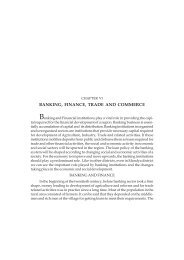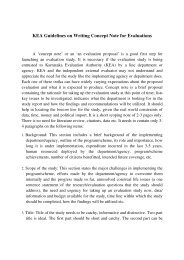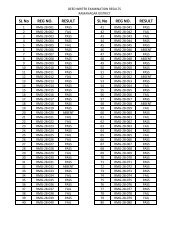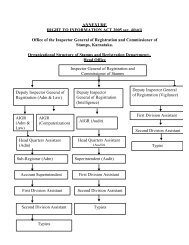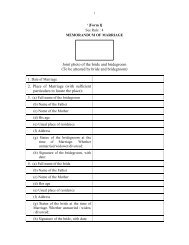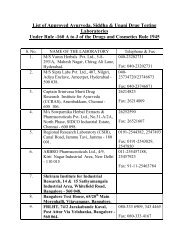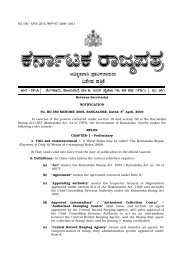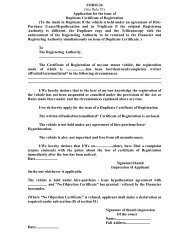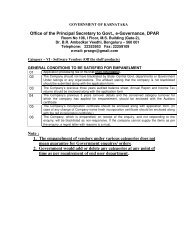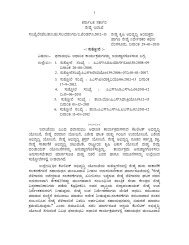Chapter-9 - Government of Karnataka
Chapter-9 - Government of Karnataka
Chapter-9 - Government of Karnataka
You also want an ePaper? Increase the reach of your titles
YUMPU automatically turns print PDFs into web optimized ePapers that Google loves.
Administration and Revenue 573granted to persons belonging to the scheduled castes and scheduled tribes, canbe granted to the following persons :i) Dispossessed tenants who are not registered as occupants; ii) displacedtenants having no land; iii) landless agricultural labourers; iv) landless personsand ex-military personnel whose gross annual income does not exceed rupeestwo thousand; V) released bonded labourers; and vi) other persons residingin villages in the same panchayat and whose gross annual income does notexceed rupees two thousand.Land Reforms Appellate AuthorityLand Reforms Appellate Authority had been set up according to theprovisions <strong>of</strong> section 116 A <strong>of</strong> the Land Reforms Act, 1961. It was functioningwith a judicial member <strong>of</strong> the grade <strong>of</strong> civil judge and a revenue member <strong>of</strong> thedeputy commissioner’s grade.An appeal could be made to the Appellate Authority concerning anydecision or order <strong>of</strong> the Tribunal. The Appellate Authority could exercise itspowers as a court following the code <strong>of</strong> civil procedure. The judicial memberand the revenue member used to hear appeals and pass orders. In case <strong>of</strong> anydifference between the decision <strong>of</strong> the Tribunal and that <strong>of</strong> the AppellateAuthority, the judicial member could refer the matter to the Principal CivilJudge <strong>of</strong> the area concerned. The Principal Civil Judge was empowered to passsuitable orders. The district level land reforms appellate authorities were doneaway with by the State <strong>Government</strong> from 8-10-1990.Disposal <strong>of</strong> <strong>Government</strong> LandsFormerly, no definite rules existed in regard to grant <strong>of</strong> lands. However,portions <strong>of</strong> uncultivated or waste lands used to be granted to certain sections<strong>of</strong> the community as a reward for services rendered. Sometimes, such landswere disposed <strong>of</strong> through public auction. The main purpose <strong>of</strong> such grants wasto encourage cultivation. After Independence, it was decided by governmentto give priority in land grants to persons belonging to weaker sections <strong>of</strong> thecommunity, landless labourers and others. In the year 1958, a uniform landgrant rules was introduced for the whole state.The land grant rules <strong>of</strong> 1950 were cancelled, and in 1968 new rules wereintroduced, which were further modified in 1969. The new <strong>Karnataka</strong> LandGrant Rules were introduced under article 197 <strong>of</strong> the 1964 Act from 3-5-1969.According to the new rules, the first priority while granting lands is accordedto the landless persons residing in the village concerned. They are followed



